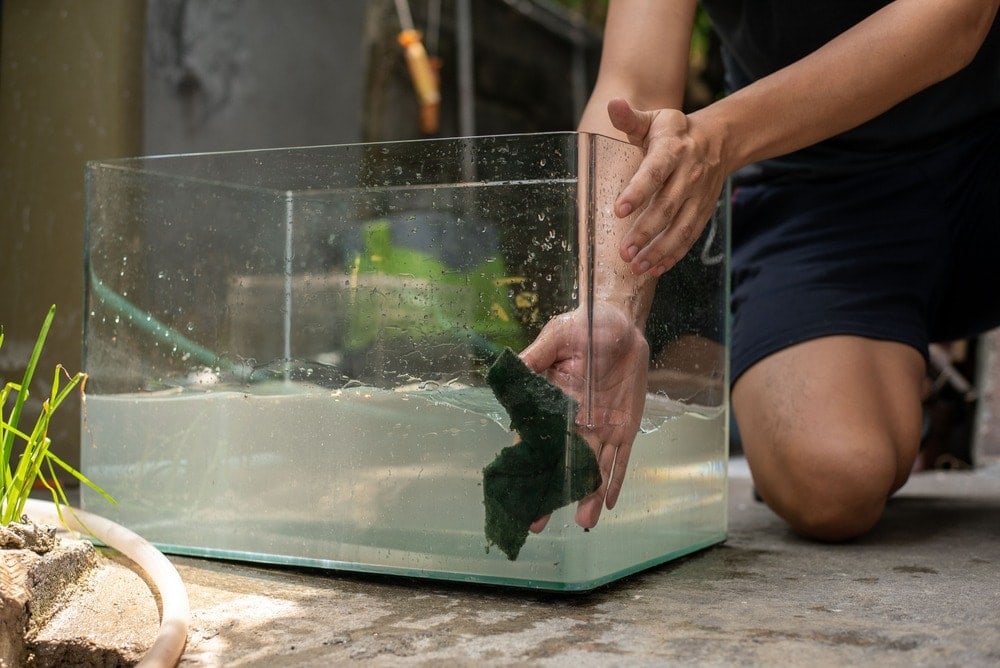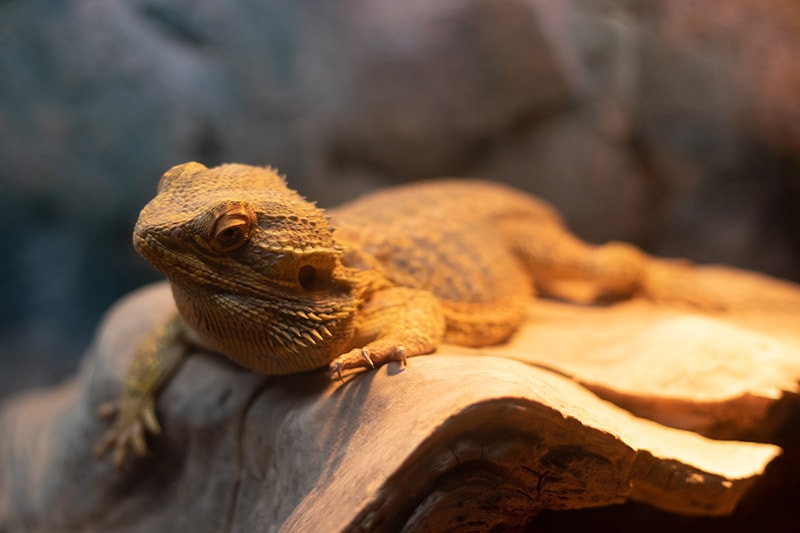20 Incredible & Fun Bearded Dragon Facts
By Ashley Bates
Updated on
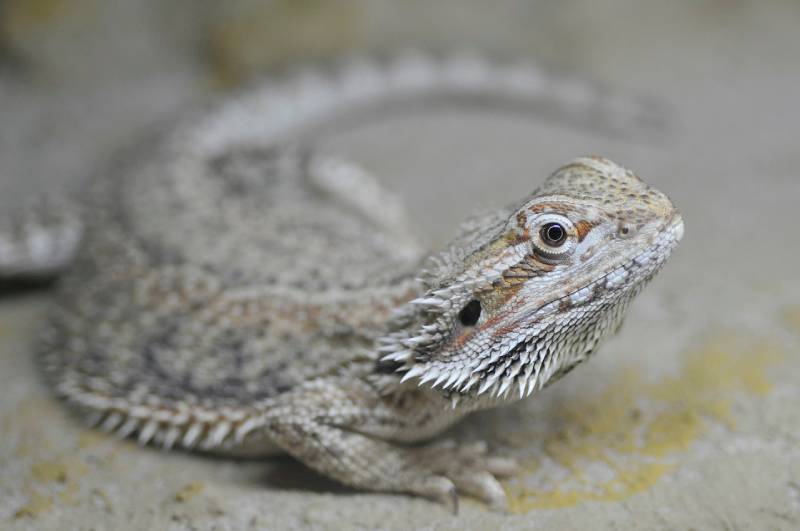
Bearded Dragons are one of the most popular reptiles in captivity today. Folks tend to really appreciate their demeanor, as they are one of the most social reptiles you can have. For this reason, they make an excellent choice for novice owners, responsible children, and anyone who appreciates and loves cold-blooded critters.
If you thought you knew a lot about bearded dragons, we could fill you in on some details you haven’t heard yet. Here are 20 incredible facts about bearded dragons that will only make you love them more.
The 20 Bearded Dragon Facts
1. Beardies Can Nod and Wave
One of the things that might make a beardie so adorable is its ability to nod and wave. They use these communication tactics not in the same way that people do.
Nodding typically doesn’t have a good connotation, which signals that the bearded dragon feels uncomfortable in its environment. It could be stressed out, sensing a threat, or even using it as a mating technique.
Unlike nodding, which is a sign of dominance, waving is a sign of submission. Dragons that are in submissive positions typically display waving behavior.
2. Bearded Dragons Can Change Colors
If you feel like you are watching your bearded dragon change colors, it’s not just your imagination! It’s an authentic thing. Bearded dragons can change colors for several reasons. Generally, this falls under two umbrellas: temperature control and communication.

3. If a Bearded Loses a Tooth—It Regrows!
Bearded dragons don’t often have to worry about their dental health! If they lose a tooth, they’ll grow it right back. This helps in nature, as sometimes, bearded dragons’ teeth can get broken off.
Now, the dental lamina is relevant for some, but not all of its teeth—and it’s a super rare phenomenon among animals! If they lose monophyodont teeth, they are gone for good, but polyphyodont teeth come back.
This adaptation has allowed them to continually regrow their teeth like an octopus regrows its legs!
4. Beardies Have Chins That Can Turn Black
If your bearded dragon sees their reflection or actually witnesses another male around, their chin might turn black as the night! This can be a defense mechanism. That’s how you know your beardie means business—along with head bobbing.
However, it can also be a way to attract a mate. Males with darker beards use this quality to prove how suitable they would be as a genetic donor. If a female chooses them, reproduction will ensue, and the species will carry on.
5. Bearded Males Can Become Female
What is interesting about bearded dragons is that males can become females if the temperature is right. So how does this happen? When eggs are incubated below 32 degrees Celsius, bearded dragons with two Z chromosomes become male.
In the same conditions, dragons with a Z and W chromosomal makeup developed as females. However, if temperatures rise above that 32-degree threshold, male dragons can reverse development, becoming female instead—it’s a process called temperature override. It’s pretty crazy science!
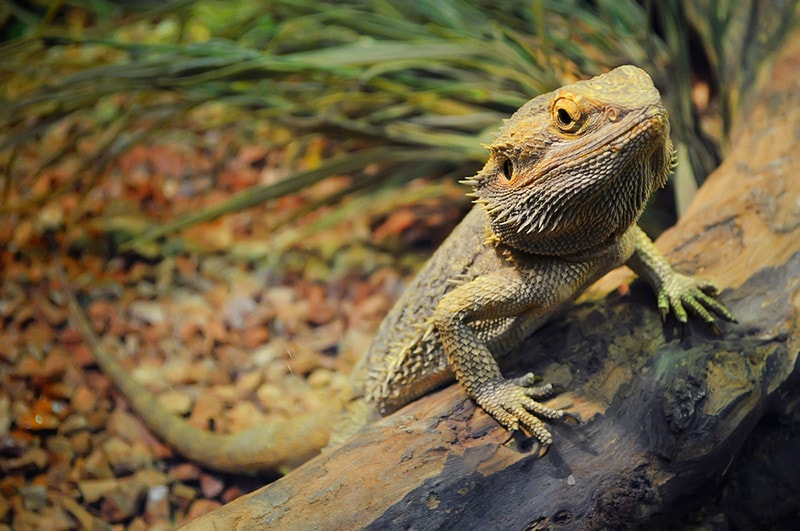
6. Female Beardies Can Store Sperm for Later Reproduction
What is really cool about the female bearded dragon is that they don’t always need a male present to reproduce. Once a female produces a clutch in a season, she can store sperm cells in her oviductal crypts for later fertilization. They can successfully lay a clutch of eggs without a second physical mating.
This tactic ensures the success of future bearded dragons when mates are few and far between. It’s a pretty incredible superpower that these females have!
7. Bearded Dragons Love Climbing Trees
You might have already noticed that the bearded dragon loves to climb. You probably have tons of perches and limbs in the cage or enclosure so they can have fun.
Bearded dragons are very efficient at climbing trees and other inclines, and they also love basking on a good log! So, if you have a bearded dragon with no limbs to climb on in the enclosure, consider getting some for their instinctual pleasure.
8. Beardies Can Carry Water on Their Heads
A bearded dragon’s natural habitat is an arid desert. Since water is very scarce, evolutionary wise, they have made up for that by being able to store water. You might see your beardie dunk their head in water, and it’s mostly to keep some for later.
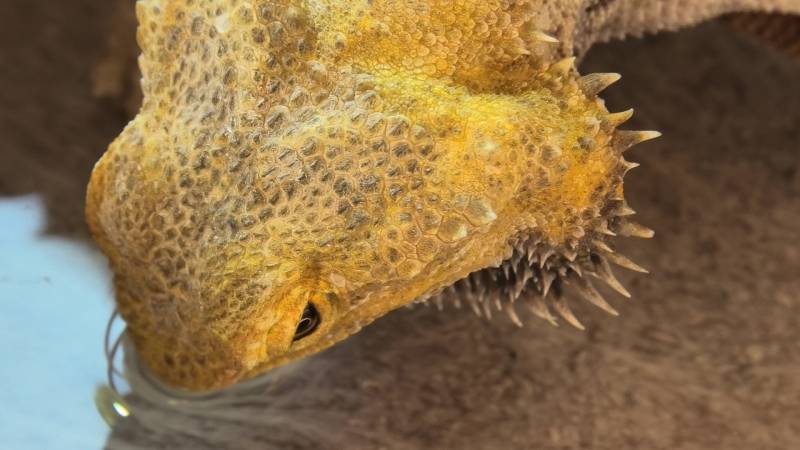
9. Bearded Dragons Can Sleep Vertically
While it might look uncomfortable, bearded dragons are quite comfortable sleeping vertically. In the wild, bearded dragons often sleep in trees. You might wonder how this is possible, but thanks to their incredible muscle capabilities and sharp claws, they can easily sustain themselves in this upright position. They simply lock their legs and hang out.
However, most often, you’ll see them sleeping on their stomachs horizontally, or slightly at a tilt. You might notice that your beardie has a preference for basking as opposed to sleeping in the enclosure.
- Related Read: Why Is My Bearded Dragon Sleeping So Much?
10. Bearded Dragons Are Omnivorous
Unlike some other reptiles, bearded dragons are omnivorous and need both animal and plant matter to keep them healthy. As juvenile bearded dragons, they will eat a very high protein diet mainly consisting of insects.
A juvenile beardie is almost totally carnivorous but needs much more from plants as they get older. You might feed your beardie lots of protein-rich insects like mealworms and crickets. But they also need lots of leafy greens and other veggies. Veggies become more of a staple as they age.
Juveniles need roughly 80% insects and 20% plants. Adults require a 50/50 mix.
11. Bearded Dragons Have Been Around Since the Dinosaurs
Your bearded dragon is old, old, old! In fact, the bearded dragon’s lineage traces back to the dinosaur days. That means beardies witnessed T-rexes at one point. Can you believe that?
It’s estimated beardies have been around for 250 million years! The Dracorex is a pachycephalosaur and the closest related dinosaur to the bearded dragon.
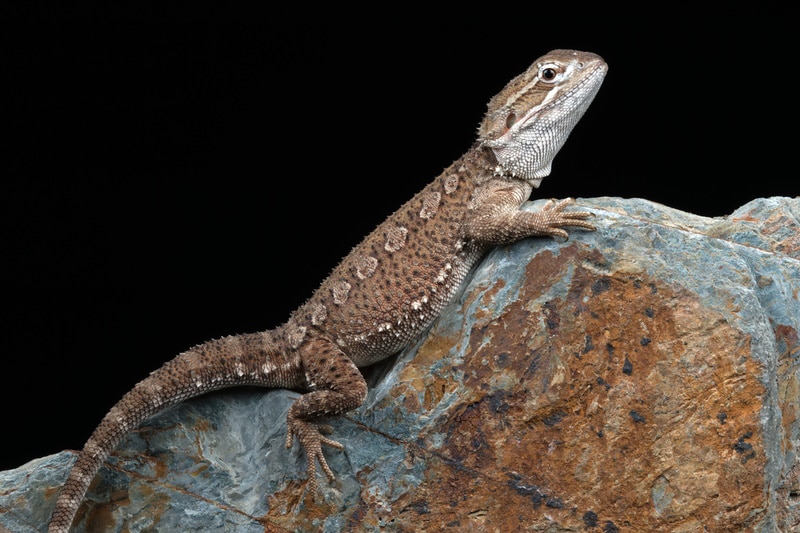
12. Fresh Baby Beardies Are the Size of Your Pinky Finger
When a bearded dragon hatches from its egg, it is one tiny little baby. They are the size of your pinky, roughly. A hatchling weighs approximately 4 grams and is only 3 inches at birth. They grow steadily and get as long as 24 inches as adults.
13. Bearded Dragons Can Run as Fast as People
What’s really impressive and quite terrifying to consider is that bearded dragons can run as fast as people! The average run time for a human biological male is 8 mph. The average run time for a human biological female is 6.5 miles per hour.
Bearded dragons can win any race, as they top out at 9 mph. So that means these little lizards can scoot! That is why it’s always important to secure your bearded dragon and not let them get out of your sight! If you ever get in a race with a bearded dragon, just be prepared to lose now.
14. Bearded Dragons Are Very Social for Reptiles
While bearded dragons can be very territorial with one another, they are also super social and tend to stay in groups. Bearded dragons are even social with people! Most reptiles want to be completely alone both in the wild and in captivity.
Many people find it enriching to interact with their beardies because they seem so in tune. This quickly made them a favorite among reptile lovers and also makes them an excellent candidate for a first-time owner.
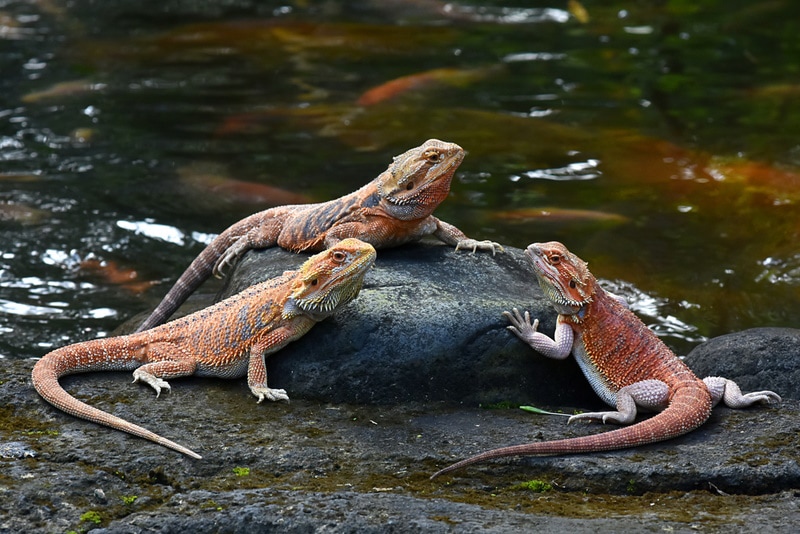
15. Bearded Dragons Do Not Pee Liquid
You might have noticed that you never find pee in your bearded dragon’s enclosure. That’s because they don’t traditionally pee liquid as a dog or cat would. Instead, the white particles in their waste indicate concentrated portions of urine.
This concentration is a substance called urate which can be white to yellow depending on the minerals therein. Typically, this white and yellow concentration is mixed with darker poop. But if your beardie’s excretion is only white, it can be caused by overhydration, lack of appropriate food, or even too much calcium.
16. Like Many Reptiles, They Carry Salmonella
It might not be too much of a surprise that bearded dragons can carry salmonella. These germs are found in their droppings and can spread to their bodies or enclosures. This is why it is so important to wash your hands after handling your bearded dragon, or any reptile for that matter.
Salmonella can poison you and make you very sick. It is crucial to keep your bearded dragon’s enclosure nice and tidy to decrease exposure risks. Always remember to sanitize after contact! Wear gloves whenever you clean the tank to reduce the transmission risk.
17. Bearded Dragons Can Be Bicephalic
What we find super interesting about a bearded dragon is that it can be born with two heads. Not only can they be born with this unique deformity, but they can live full lives without a problem in rare cases. Bicephalous beardies are just as capable as any other, permitting that they live through improbable survival odds.
Statistically, of all beardies born, there is a 1 in 25 million chance it will survive. While that’s quite a drastic gamble, the capability of this two-headed dragon living is quite impressive!
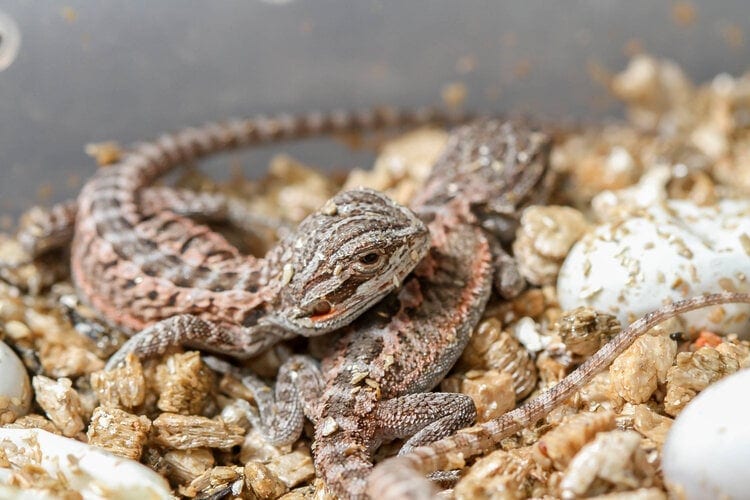
18. Beardies Brumate in Winter Months
In the colder months, you might notice your beardie getting more lethargic and sleepier than usual and it’s not your imagination! These reptiles have to naturally slow down in the wintertime—even if they are indoors in perfectly toasty temperatures. It’s just instinct!
Brumation is a survival tactic that allows bearded dragons to live when temperatures drop, and food is scarce. This process reduces their metabolism, so they don’t use up as much stored energy.
19. You Can Walk Your Bearded Dragon!
You might have seen pictures of people walking around their bearded dragons as if they were dogs. The truth is that beardies love going out for adventures. They can skedaddle quite quickly when they want to and benefit quite significantly from the exercise and exploration.
You can buy harnesses explicitly designed for bearded dragons on sites like Chewy and Amazon.
Related reads:
- How to Train Bearded Dragons: 6 Simple Steps
- 6 DIY Bearded Dragon Leash Plans You Can Make Today (With Pictures)
20. Bearded Dragons Have a Beard, But No Hair
The bearded dragon’s name might be misleading. After all, it sounds like they will have a full chin of scruff. However, if you spent any time with the bearded dragon, that’s not the case. Rather than having any hair follicles, they have a beard of spikes that are soft to the touch unless they are upset.
When a bearded dragon feels threatened or acts territorial, it puffs up its spikes on the chin, turning very dark. This is how they make themselves look bigger to potential threats or predators. It is a classic trademark of the breed and one of the reasons we love them so much.
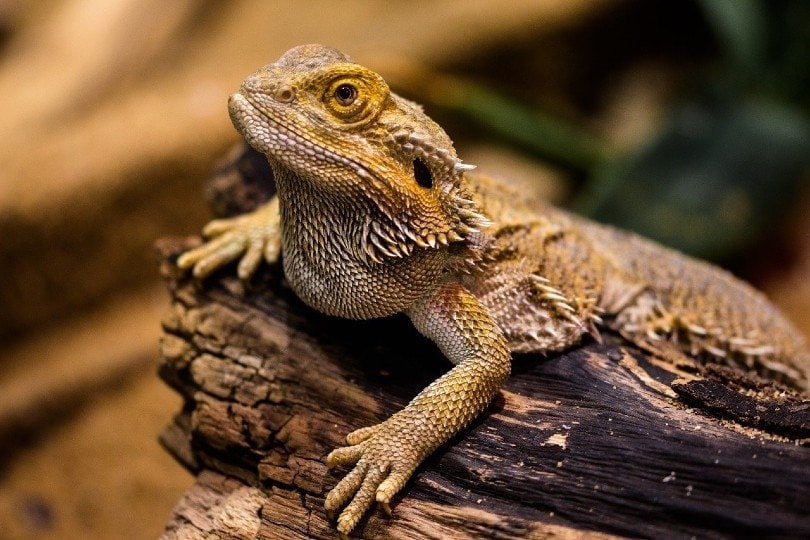
Conclusion
Did you learn anything new and interesting about a bearded dragon today? If these are your favorite reptiles, we hope we’ve given you some information you can take with you when you go. These friendly, common sun-loving cuties are extremely unique, after all.
There is so much more to learn about these critters, so don’t stop here. Especially if you’re going to own a bearded dragon, you can never know enough. Experience and education ensure that you give your pet the best life possible while in captivity.
See Also:
- 9 Common Bearded Dragon Diseases and Health Issues to Look Out For
- Are Bearded Dragons Good Pets? Vet Reviewed Pros & Cons
Featured Image Credit: gek-ko, Pixabay

